#Qutb Minar
Explore tagged Tumblr posts
Text

QUTAB MINAR - INDIA
62 notes
·
View notes
Text
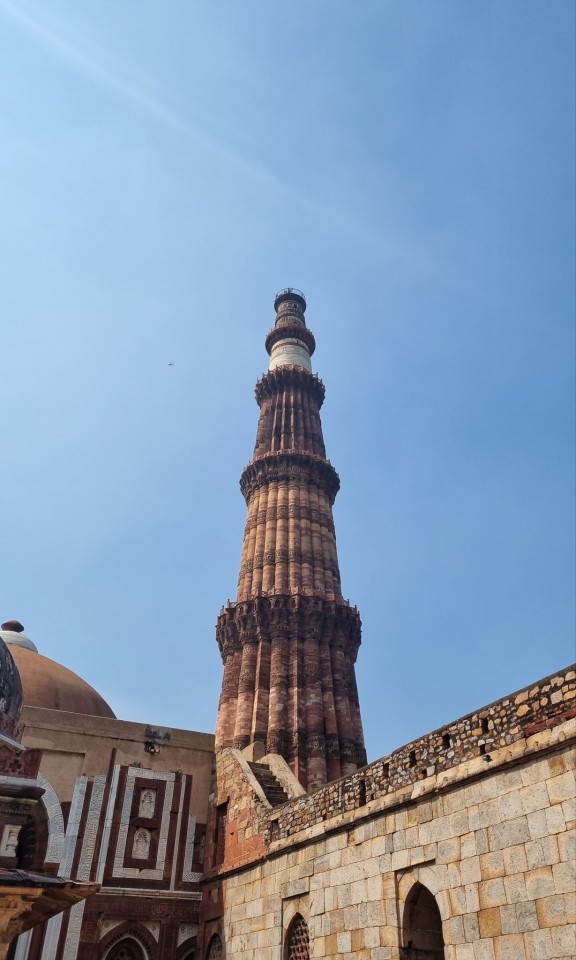
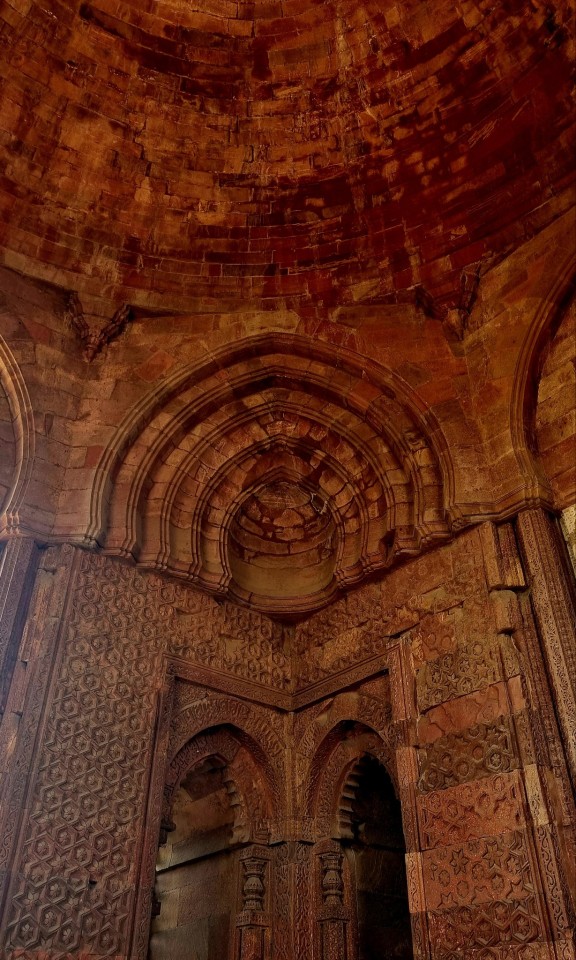
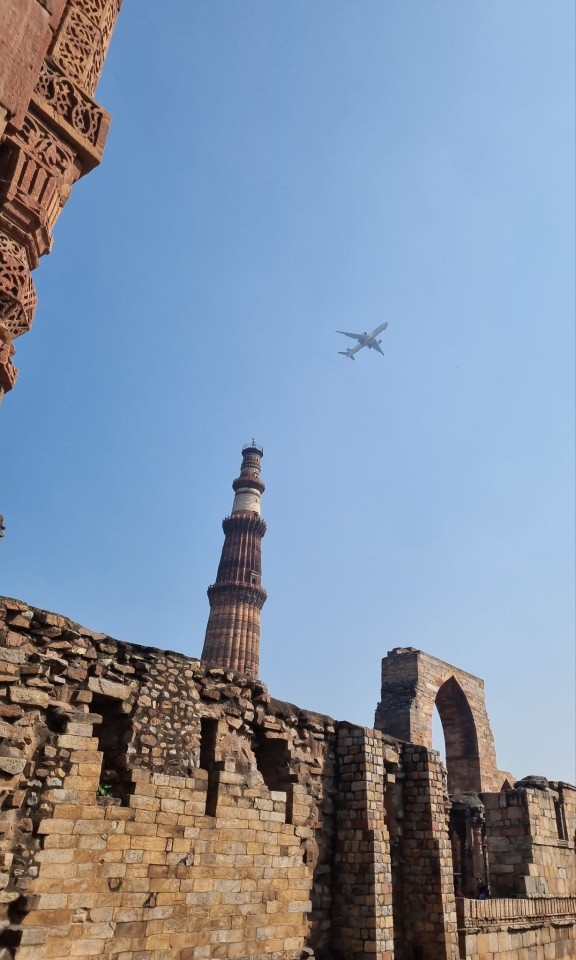
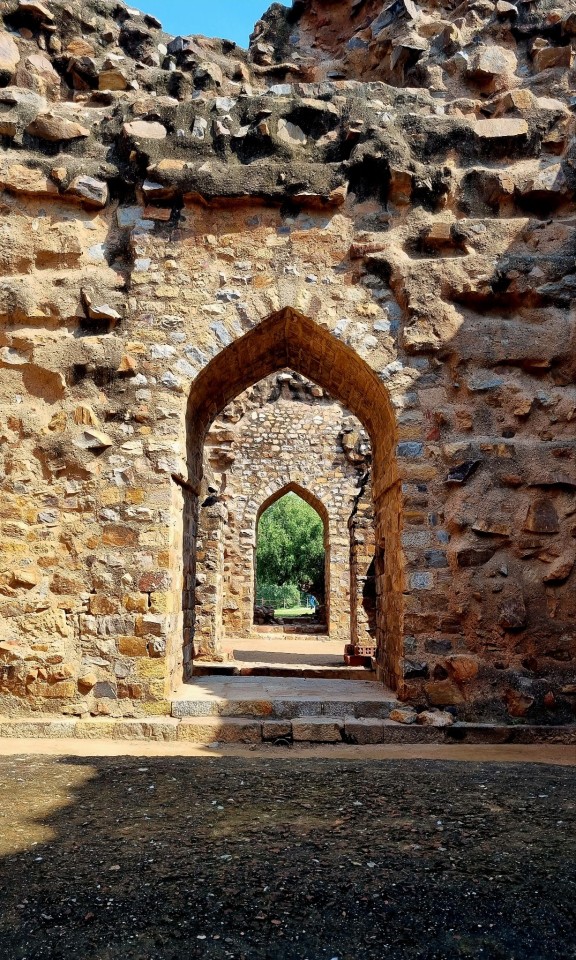
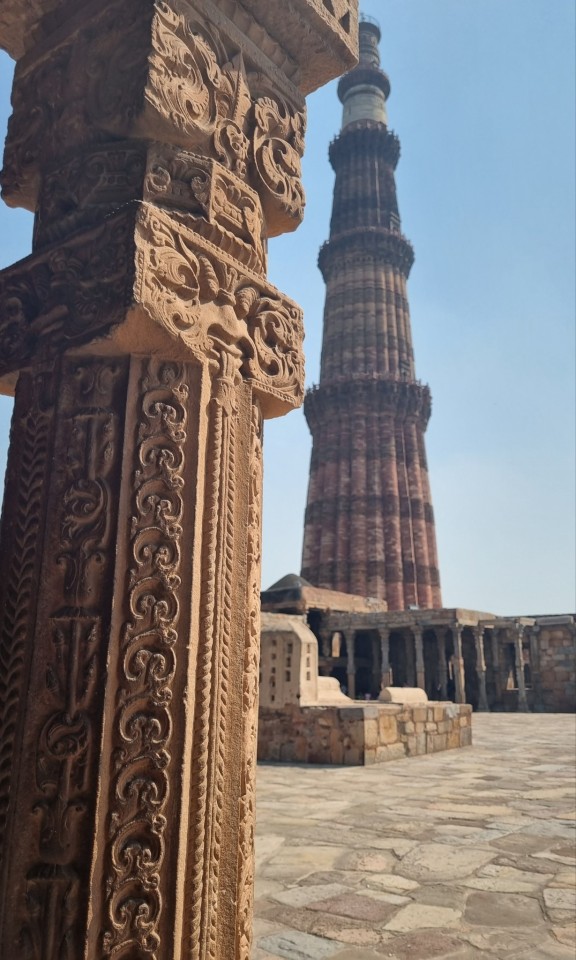
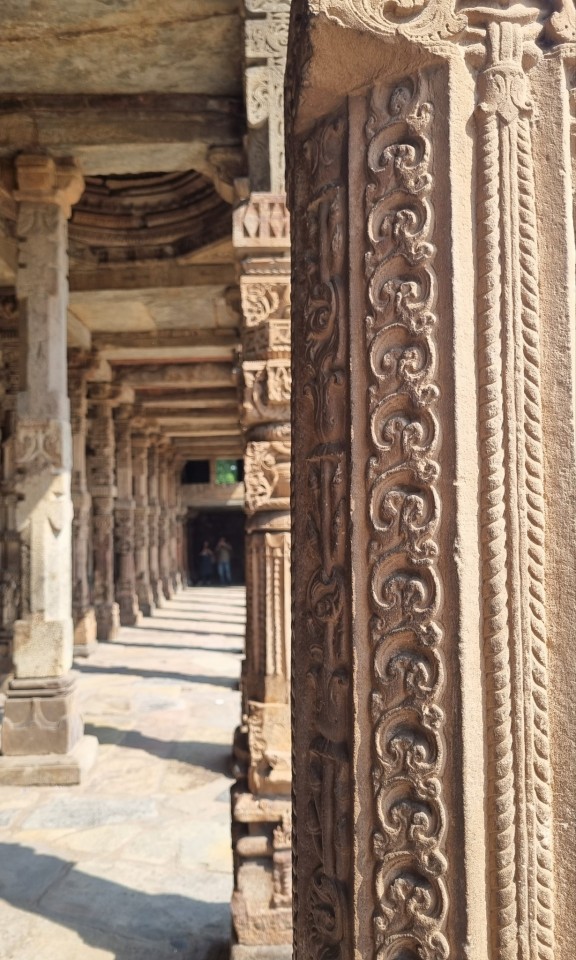

Please like or repost if downloading. Please give credit if you're sharing it online.
#qutub minar#history#monuments#dilli#delhi#new delhi#india#cultural#asia#delhi sultanate#mughals#mehrauli#qutub complex#indo islamic architecture#qutb ud din aibak#iltutmish#tughlaq dynasty#lodi dynasty#wallpaper#historical wallpapers#phone wallpapers#indian monuments#historical monuments#for you#trending#tumblr
10 notes
·
View notes
Text
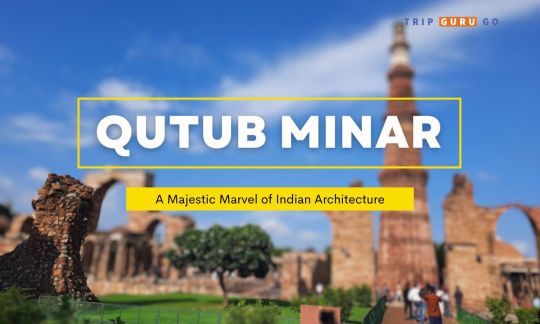
#Qutub Minar#Indian Architecture#UNESCO World Heritage Site#Delhi#India#Indo-Islamic Architecture#Historical Landmark#12th Century Monument#Majestic Tower#Cultural Heritage#Tourist Attraction#Architectural Marvel#Delhi Sightseeing#Qutb Complex#Delhi Tourism#Heritage Conservation
0 notes
Text
NAHHH I DON'T WANNA GO HOMEEEEEE TvT
Basically I have been travelling since Tuesday, and today is finally the day I'm returning back to Mumbai. So, me and my family had come for a short trip to Delhi and one day to Agra, and it was so mesmerizing!! My mom was so elated when she could finally catch a glimpse of her childhood place, i.e, East of Kailash in Delhi! :D
These days were so fun, istg. I went inside Qutb Minar (and yeah, ofc Chand Sifarish was going on in my mind), Red Fort (Diwan-i-aam had the place where the Emperor sat and addressed his people, yk, an elevated area like we can see in the movie Jodhaa Akbar, his aasan was kept down so that we could have a glimpse of it, it was made out of marble. Entry wasn't allowed inside Diwan-i-khaas, but the intricate designs and carvings of marble there would just keep anyone wondering how the people of that time had such amazing skills when technology wasn't available, and yes, the most amazing part is, EVERYTHING WAS FREAKING HAND-MADE!!!!), Lotus temple (it's beautiful from the outside, but there wasn't really anything to explore inside since it's just a huge prayer room where people came to meditate and pray). We caught glimpses of the India Gate, Rajpath, Rashtrapati Bhawan, Supreme Court, and ofc, a posche area like Connaught Place couldn't be missed!! We explored well-known market places like Karol Bagh, Lajpat Nagar and Sarojini Market.
Now coming to Agra. Our travelling time from Delhi to Agra was around 3.5 hours as we travelled through the expressway. Visited the grand Taj Mahal that day itself, and that sight took over my heart! It looks even more beautiful in reality than it does in pictures! Got to know a lot about the place, the designs which were made of gemstones, visited Shah Jahan and Mumtaz Mahal's tombs inside (photography inside wasn't allowed), and so much more which I can't really explain in detail via this post. The next day, we went to Agra Fort, which covered about 3 km in area (yes it's that huge). Only 25% of the Fort is open for public, the rest of 75% has been occupied by the Indian Army, but just the 25% of the Fort really told us about the history of the Mughals. Mehtaab Bagh, where Shah Jahan wanted to build a black Taj Mahal for him, was visible from the Agra Fort. Building Taj Mahal required 60% of their wealth, and the leftover could not have been used to build another Taj Mahal, hence it could not be completed, and today, we can only see the platform which could be built only.
Fact - their security measures were insane. The front side of the Fort had huge gorges where crocodiles and Gharials were kept. There was also a small area of dense trees having wild animals ahead the gorge. So that means, any intruder who came inside would be instantly killed by these animals. Wild! These animals were kept hungry the whole night and given food in the morning intentionally so that they remain vigilant, hungry and ferocious the whole night in case anyone tries to enter and attack.
Yep, the days went like this!!
😄😄😁😁
7 notes
·
View notes
Note

Qutb minar ki photo Maine uthai
I was so proud of myself
aree waaaah sundarrr haiiii :)
4 notes
·
View notes
Text
Barni scrive,... il governo del Sultano stava vacillando quando la morte lo colse. Alcuni dicono che il famigerato Malik Naib Kafur abbia aiutato la sua malattia a terminare fatalmente. Le redini del governo caddero nelle mani di schiavi e di gente senza valore; non rimase alcun saggio a guidarlo, e ognuno fece quello che voleva.
Il 6 di Shawwal, verso mattina, il cadavere di Alauddin fu portato fuori dal Palazzo Rosso di Siri e fu sepolto in una tomba di fronte alla Jami Masjid (nel complesso del Qutb Minar).
Il secondo giorno dopo la morte, Kafur riunì a palazzo i principali nobili e ufficiali e presentò un testamento del defunto Sultano che aveva fatto eseguire a favore di Malik Shihabuddin Omar, togliendo a Khizr Khan la carica di erede.
Con il consenso dei nobili mise Shihabuddin sul trono, ma poiché il nuovo sovrano era un bambino di soli cinque o sei anni, era un semplice fantoccio nelle mani degli intrallazzatori. Lo stesso Malik Kafur assunse la direzione del governo.
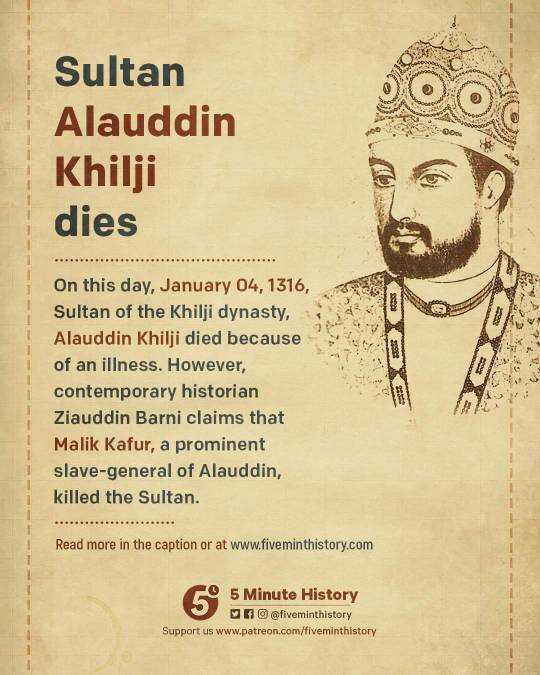
11 notes
·
View notes
Photo
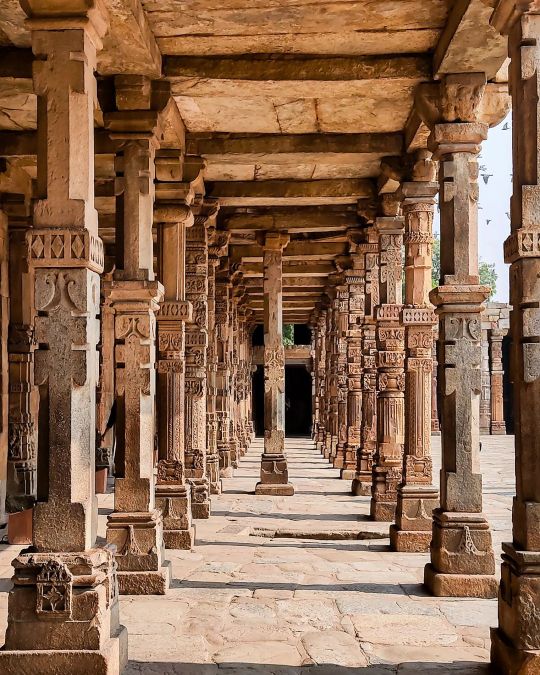
Carved pillar passage Qutub Complex The Indian Slave Dynasty (Mamluk Dynasty) lasted from 1206 to 1290, almost a century. The list of sultans is as follows Qutb ud-Din Aibak (1206 – 1210 AD) Aram shah (1210 – 1211 AD) Iltutmish (1211 – 1236 AD) Rukn-ud-din-Firoz (1236 AD) Razia al-Din (1236 – 1240 AD) Muiz-ud-din Bahram (1240 – 1242 AD) Ala-ud-din Masud (1242 – 1246 AD) Nasir-ud-din Mahmud (1246 – 1266 AD) Ghiyas-ud-din Balban (1266 – 1285 AD) Muiz-ud-din Muhammad Qaiqabad (1286 – 1290 AD) #qutubminar #delhi #worldheritagesite #history #carving #stonestructures #stonecarving #historyofindia #slavedynasty #lalkot #qutubcomplex #window #ancientmarvels #india #phonephotography #photography #mumbai #maharashtra #redsandstone #marble #delhidiaries #quwwatulislammosque # (at Qutub Minar) https://www.instagram.com/p/Cl2wjWHykQV/?igshid=NGJjMDIxMWI=
#qutubminar#delhi#worldheritagesite#history#carving#stonestructures#stonecarving#historyofindia#slavedynasty#lalkot#qutubcomplex#window#ancientmarvels#india#phonephotography#photography#mumbai#maharashtra#redsandstone#marble#delhidiaries#quwwatulislammosque
3 notes
·
View notes
Video
youtube
Delhi Sultanate EXPERT Shares Qutub Minar Secrets
Discover the secrets of India's tallest Qutub Minar in this video! Explore the controversy, Alai Minar, and a day in this UNESCO world heritage site. The Qutub Minar is one of the most iconic symbols of the Delhi Sultanate, a historic Islamic empire that ruled parts of the Indian subcontinent from the 13th to the 16th century. The Qutub Minar stands in the Qutb Complex in Mehrauli, Delhi, and is a UNESCO World Heritage Site, showcasing a fine blend of Islamic and Hindu architectural styles. Key Points about Qutub Minar and the Delhi Sultanate:
0 notes
Text
Delhi Sightseeing Tour
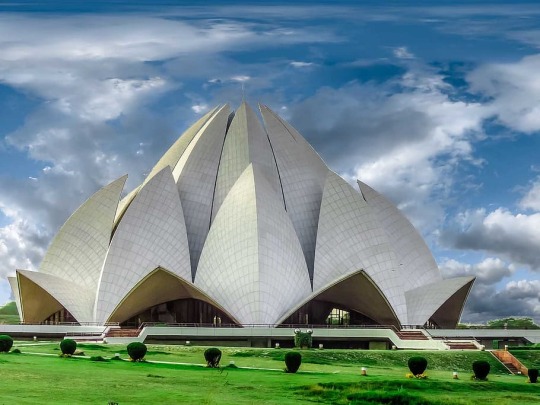
Delhi Sightseeing Tour: Discovering the India's Heart
The energetic capital of India, Delhi, is a city where modernism and history coexist peacefully. Delhi, with its rich centuries-spanning cultural legacy, presents a varied spectrum of experiences from historic sites to busy markets and contemporary marvels. A Delhi sightseeing trip offers a chance to fully experience the modern vitality of the city while also exploring its intriguing past.
This post will walk you through a flawless one-day Delhi sightseeing trip itinerary including the must-see sites and secret jewels defining this famous city.
1. India Gate: Honours Courageous Soldiers Starting from one of Delhi's most well-known sites, India Gate, your sightseeing trip might Constructed as a tribute to the men lost in World War I, this massive 42-meter-high arch stands as a national pride emblem. Particularly in the early morning when the air is clear, the verdant grass around India Gate attract both residents and visitors.
Remember to stroll around the Amar Jawan Jyoti, an everlasting light burning in remembrance of the unknown troops. The sight of India Gate before sunrise is particularly breathtaking, offering a calm start to your journey.
2. Rashtrapati Bhavan: The Presidential Palace Just a short drive from India Gate stands Rashtrapati Bhavan, the official house of the President of India. This huge house, with its expansive grounds and spectacular architecture, is a must-see for those interested in colonial history. Designed by Sir Edwin Lutyens, the edifice exhibits the grandeur of British colonial architecture combined with Indian influences.
While the interior of the palace is not always open to the public, you can tour the Mughal Gardens during specific months and enjoy the well-manicured lawns, blossoming flowers, and quiet environment.
3. Humayun’s Tomb: A UNESCO World Heritage Site Next, proceed to Humayun’s Tomb, a UNESCO World Heritage Site and one of the best specimens of Mughal architecture. This exquisite monument, built in the 16th century, is frequently considered a predecessor to the Taj Mahal due to its comparable style. Surrounded by rich gardens, the tomb stands as a tribute to Mughal creativity and architectural skill.
Wander through the Charbagh (four gardens) arrangement, a typical Persian-style garden design, and see the magnificent symmetry of the tomb. The beautiful craftsmanship on the red sandstone facade, paired with the tranquil surroundings, makes this a must-visit stop on any Delhi sightseeing tour.
4. Qutub Minar: A Marvel of Ancient Engineering Another highlight of your journey is the renowned Qutub Minar, the tallest brick minaret in the world, standing at 73 meters. This UNESCO World Heritage Site is a spectacular example of Indo-Islamic architecture, created in 1193 by Qutb-ud-din Aibak.
The complex around the Qutub Minar includes other historical structures, such as the Quwwat-ul-Islam Mosque and the Iron Pillar, which has stood rust-free for over a thousand years. The Qutub complex is a fascinating peek into India’s medieval history and offers plenty of photo opportunities.
5. Lotus Temple: A Symbol of Unity For a modern architectural marvel, explore the Lotus Temple, noted for its unusual flower-like design. This Bahá'í House of Worship is open to individuals of all faiths and provides a calm environment for meditation and reflection. The temple’s remarkable architecture, with 27 white marble petals, makes it one of the most photographed monuments in Delhi.
Surrounded by beautifully landscaped gardens, the Lotus Temple offers a calm respite from the rush and bustle of the city. It’s a wonderful site for anyone seeking some spiritual serenity during their Delhi sightseeing tour.
6. Red Fort: A Glimpse into Mughal Glory No tour of Delhi is complete without visiting the Red Fort. This UNESCO World Heritage Site was the royal home of Mughal monarchs for approximately 200 years. Built by Emperor Shah Jahan in 1648, the fort is an architectural wonder made of red sandstone. The fort’s huge walls and exquisite palaces are a testimony to Mughal splendour.
Take a trip around Diwan-i-Aam (Hall of Public Audience) and Diwan-i-Khas (Hall of Private Audience), where the emperor previously held court. If you visit in the evening, don’t miss the sound and light display, which brings the fort’s history to life.
7. Jama Masjid: India’s Largest Mosque Just a short distance from the Red Fort is Jama Masjid, India’s largest mosque and another architectural masterpiece erected by Shah Jahan. With its majestic domes and tall minarets, Jama Masjid can house up to 25,000 worshippers at once. The mosque’s magnificent courtyard affords a panoramic perspective of Old Delhi, making it a perfect site for photography.
Visitors are encouraged to tour the mosque’s stunning interiors and enjoy the unique Mughal-era craftsmanship. However, bear in mind that it is a place of worship, so dress modestly and be respectful of the religious customs.
8. Chandni Chowk: A Shopper’s Paradise After seeing the ancient landmarks, immerse yourself in the frenetic energy of Chandni Chowk, one of Delhi’s oldest and biggest markets. This bustling region is a sensory explosion, replete with the sights, sounds, and scents of traditional Indian bazaars. From street food sellers selling chaat and parathas to shops offering textiles, jewelry, spices, and gadgets, Chandni Chowk has it all.
If you’re feeling daring, take a rickshaw ride through the small aisles of the market. It’s an encounter that delivers a true taste of Old Delhi’s tumultuous appeal.
Conclusion A Delhi sightseeing trip is a voyage through time, affording a glimpse into India’s magnificent past while embracing the modernity of today. From the towering monuments of the Mughal era to bustling bazaars and quiet temples, Delhi has something for everyone. Whether you’re a history buff, a shopaholic, or simply looking to experience a dynamic city, Delhi never disappoints.
FAQs 1. How long does a typical Delhi sightseeing trip last? A normal Delhi sightseeing tour lasts a full day, usually around 8 to 10 hours, depending on how many attractions you choose to visit.
2. Is it required to hire a guide for Delhi sightseeing? While it’s not necessary, having a guide can enhance your experience, providing historical context and intriguing details about the landmarks.
3. What is the ideal time to visit Delhi for sightseeing? The greatest time to visit Delhi is during the winter months, from October to March, when the weather is mild and excellent for outdoor activities.
4. Are there any entrance fees for the historical monuments? Yes, most of Delhi’s ancient landmarks, such as the Red Fort, Humayun’s Tomb, and Qutub Minar, have entrance fees. Foreign tourists frequently pay higher rates than Indian ones.
5. What are some must-try local dishes on the tour? Don’t miss out on Delhi’s famous street food like chaat, parathas, and jalebi. If you’re visiting Chandni Chowk, eat the food at Paranthe Wali Gali or savour classic Mughlai delicacies in the adjacent restaurants.
0 notes
Text
Same day Delhi tour by car By Private tour guide India Company.

Same Day Delhi Tour by Car with Private Tour Guide India Company
Delhi, the capital of India, is a bustling metropolis rich in history, culture, and modernity. With its ancient monuments, lively markets, and stunning architecture, it’s a city that perfectly blends the old with the new. A Same Day Delhi Tour by Car is a fantastic way to experience the essence of this vibrant city. Whether you're a history enthusiast, a shopaholic, or someone looking to explore the flavors of India, this tour offers a personalized experience tailored to your interests.
Why Choose a Same Day Delhi Tour by Car? A one-day tour of Delhi by car offers the flexibility and convenience to explore the city at your own pace. Here’s why it’s the perfect choice:
Comfortable Travel: Traveling by a private air-conditioned car ensures a comfortable journey, especially during hot summer days or cold winters. Customizable Itinerary: You can choose which landmarks and neighborhoods to visit, ensuring a personalized experience. Private Guide: Having a professional guide by your side enhances your understanding of the historical and cultural significance of each site. Efficient Exploration: A car allows you to cover more ground quickly, making the most of your time in this sprawling city. Tour Highlights During your Same Day Delhi tour, you will visit some of the most iconic landmarks, including:
Qutub Minar India Gate Humayun’s Tomb Lotus Temple Jama Masjid Raj Ghat Red Fort Rashtrapati Bhavan (Presidential Residence) Chandni Chowk (Optional market visit) Detailed Itinerary Morning: Pickup and Start of Tour Your tour starts with a pickup from your hotel or a preferred location in Delhi. A comfortable, air-conditioned car will be ready to take you on your journey through the city. Your private guide will greet you and provide a brief overview of the day's itinerary.
Stop 1: Qutub Minar Your first stop will be the majestic Qutub Minar, a UNESCO World Heritage Site. Built in 1193 by Qutb-ud-din Aibak, this towering structure is the tallest brick minaret in the world. It stands as a symbol of the beginning of Muslim rule in India. Your guide will share fascinating stories about the minaret and its surrounding ruins, including the Quwwat-ul-Islam Mosque and the Iron Pillar.
Stop 2: India Gate Next, you’ll visit the India Gate, a war memorial dedicated to the Indian soldiers who lost their lives during World War I. This iconic monument is a must-see in Delhi, surrounded by lush green lawns. You can take a leisurely walk around the monument and enjoy the serene atmosphere while your guide shares the significance of the memorial.
Stop 3: Rashtrapati Bhavan From India Gate, you’ll drive past the grand Rashtrapati Bhavan, the official residence of the President of India. This sprawling estate, with its stunning Mughal gardens, is one of the largest residences of any head of state in the world. While entry inside is restricted, your guide will share intriguing facts about its architecture and history.
Stop 4: Humayun’s Tomb Next, you’ll visit Humayun’s Tomb, a magnificent garden tomb and another UNESCO World Heritage Site. Built in the 16th century, this tomb was the inspiration for the architecture of the Taj Mahal. It is a perfect example of Mughal architecture, with its symmetrical gardens, grand domes, and intricate carvings. Your guide will give you insights into the life of Emperor Humayun and the significance of the tomb’s design.
Stop 5: Lotus Temple Your next stop is the stunning Lotus Temple, famous for its unique flower-like structure. This Baháʼí House of Worship is open to people of all faiths and offers a serene environment for meditation and reflection. The temple’s architecture, inspired by the lotus flower, is a modern marvel and an example of secular spirit.
Midday: Lunch Break After a busy morning of sightseeing, it’s time for a lunch break. Your guide will recommend a local restaurant where you can enjoy a meal. Whether you’re looking to try traditional Indian cuisine or something lighter, there’s a range of options to choose from. Don’t miss the chance to sample local specialties like butter chicken, dal makhani, and naan.
Stop 6: Jama Masjid Post-lunch, you’ll head to Jama Masjid, one of the largest mosques in India. Built by Mughal Emperor Shah Jahan, this grand mosque is an architectural masterpiece with its massive courtyard, domes, and towering minarets. Your guide will share the history of the mosque, and if you're feeling adventurous, you can climb one of the minarets for a panoramic view of Old Delhi.
Stop 7: Red Fort Just a short drive from Jama Masjid is the Red Fort, a symbol of India’s rich history and a UNESCO World Heritage Site. Built in 1648, this massive fort served as the main residence of the Mughal emperors. You’ll explore the fort’s impressive halls, gardens, and museums while learning about its role in India’s colonial and post-independence eras.
Stop 8: Raj Ghat Your next stop is Raj Ghat, the memorial site of Mahatma Gandhi. A simple black marble platform marks the spot where Gandhi was cremated in 1948. This peaceful site is surrounded by gardens, making it an ideal place for reflection. Your guide will share stories of Gandhi’s life and his contributions to India’s freedom movement.
Optional Stop: Chandni Chowk If time permits, you can explore Chandni Chowk, one of Delhi’s oldest and busiest markets. This vibrant marketplace offers a glimpse into the bustling life of Old Delhi, with its narrow lanes, shops selling spices, textiles, and jewelry, and street food stalls serving delicious local snacks like jalebi and paratha.
Evening: Return to Hotel After a full day of exploring Delhi, your car will drop you back at your hotel or a location of your choice. The tour typically ends in the early evening, allowing you to relax and reflect on the sights and stories you’ve experienced.
Why Book with Private Tour Guide India Company? Booking a Same Day Delhi Tour by Car with Private Tour Guide India Company comes with many benefits:
Personalized Experience: Your guide tailors the tour to your interests, ensuring you visit the sites that matter most to you. Comfortable Travel: Private, air-conditioned transport allows you to explore the city without worrying about public transport or the weather. Expert Guides: Their knowledgeable guides provide deep insights into the history, culture, and architecture of Delhi. Conclusion A Same Day Delhi Tour by Car is the perfect way to explore the rich history and vibrant culture of India’s capital. With a well-planned itinerary and the convenience of private transportation, you can see the best of Delhi in a single day. Whether you're visiting for the first time or rediscovering the city, this tour offers a memorable experience filled with iconic landmarks, historical insights, and delicious local food.
FAQs
How long does the Same Day Delhi tour last? The tour typically lasts 8 to 10 hours, depending on the pace and traffic.
Is the tour customizable? Yes, the itinerary can be customized based on your preferences and interests.
What should I wear for the tour? It’s recommended to wear comfortable clothing and shoes, as there will be some walking involved at certain sites.
Is lunch included in the tour? Lunch is not included but your guide will recommend a good restaurant during the lunch break.
Can the tour accommodate larger groups? Yes, larger groups can be accommodated with advance notice and appropriate arrangements.
0 notes
Text
Delhi one day tour by Taj Mirror Tours Company.

Delhi One Day Tour by Taj Mirror Tours Company
Delhi, India’s bustling capital, is a city where history meets contemporary in a magnificent combination. From centuries-old monuments to vibrant bazaars and contemporary attractions, Delhi provides an unlimited selection of experiences. The Delhi One Day Tour by Taj Mirror Tours Company is the perfect approach to immerse yourself in the best of Delhi in only one day, without missing out on its rich history and culture. Whether you're a history buff, a culture enthusiast, or simply looking to experience this dynamic metropolis, this tour has something for everyone.
Why Choose the Delhi One Day Tour by Taj Mirror Tours Company? If you only have a day to visit Delhi, Taj Mirror Tours helps you make the most of your time. With a well-planned schedule, professional guides, and smooth logistics, you can enjoy a hassle-free tour of Delhi’s most renowned landmarks. The organization focuses on delivering a comfortable, instructive, and interesting experience, providing insights into the city’s Mughal, colonial, and modern-day heritage.
The Delhi One Day Tour includes visits to UNESCO World Heritage Sites, bustling markets, spiritual icons, and a taste of local food. Here's what you can expect on this fast-paced yet enriching tour.
Tour Highlights India Gate Qutub Minar Humayun's Tomb Lotus Temple Red Fort Jama Masjid Raj Ghat Chandni Chowk Delhi One Day Tour Itinerary The Delhi One Day Tour by Taj Mirror Tours covers both the ancient and modern features of the city. Below is a typical plan for a full day of exploration in India’s lively capital.
Morning: Historical Monuments 1. Qutub Minar Your tour begins with a visit to Qutub Minar, the world’s highest brick minaret and a UNESCO World Heritage Site. This spectacular edifice, built by Qutb-ud-din Aibak in 1193, is a notable example of Indo-Islamic architecture. As you explore the complex, your guide will describe the rich history of this ancient edifice and its surrounding monuments.
2. Humayun's Tomb Next, you’ll head to Humayun's Tomb, another UNESCO World Heritage Site. This exquisite mausoleum, erected in 1570, was the first garden-tomb in India and served as an architectural inspiration for the Taj Mahal. Walking through the verdant gardens and exploring the unique Mughal architecture is a pleasant experience.
3. India Gate From Humayun's Tomb, the tour goes to India Gate, an iconic war memorial that honors Indian soldiers who died during World War I. The 42-meter-high arch stands proudly in the middle of Delhi and offers a superb photo opportunity. Here, you’ll also travel by major landmarks such as Rashtrapati Bhavan (the Presidential Residence) and Parliament House.
Afternoon: Spiritual and Cultural Insights 4. Lotus Temple Your next visit is the magnificent Lotus Temple, noted for its flower-like structure. Open to individuals of all religions, this Bahá'í House of Worship is a place of meditation and serenity. The architectural beauty of the Lotus Temple, paired with its serene ambiance, makes it a must-visit attraction in Delhi.
5. Raj Ghat The tour will then take you to Raj Ghat, a simple yet powerful memorial dedicated to Mahatma Gandhi, the father of the nation. Set amid lovely gardens, Raj Ghat marks the location of Gandhi’s cremation. It is a calm pause that allows a moment of introspection amidst the hectic city.
Late Afternoon: Old Delhi’s Rich Heritage 6. Red Fort In the late afternoon, you’ll see the beautiful Red Fort, a UNESCO World Heritage Site and a symbol of India’s rich Mughal heritage. Built by Emperor Shah Jahan in 1648, this huge fort complex served as the palace of Mughal rulers for nearly 200 years. The elaborate sculptures, vast rooms, and gorgeous gardens inside the fort will take you back in time.
7. Jama Masjid Just a short distance from the Red Fort is Jama Masjid, one of the largest mosques in India. This enormous mosque, also built by Shah Jahan, can accommodate over 25,000 worshippers. Climbing to the top of its tower gives stunning views of Old Delhi’s hectic yet picturesque streets.
Evening: Old Delhi’s Bustling Markets 8. Chandni Chowk The final stop on your Delhi One Day Tour is the iconic Chandni Chowk market. This busy bazaar is one of the oldest and largest markets in Delhi, offering everything from street food to traditional garments and jewelry. Here, you’ll get a chance to explore the tiny streets filled with shops, experience a rickshaw ride, and eat traditional street food like chaat, jalebi, and parathas. The bustling atmosphere of Chandni Chowk provides the perfect finale to your day in Delhi.
What Makes the Delhi One Day Tour Special? Taj Mirror Tours has carefully crafted this tour to deliver an authentic view of Delhi’s unique culture, architecture, and history. Key features of the tour include:
Experienced Guides: Their expert guides offer in-depth insights into the city's history, architecture, and local culture. Seamless Travel: The tour is done in comfortable, air-conditioned cars, ensuring that your journey between sights is easy and pleasurable. Flexible Itinerary: Although the tour is filled with must-see sights, there is opportunity for personalization depending on your preferences and interests. Local Experiences: From tasting local street food to touring vibrant markets, the tour delivers a true flavor of Delhi. Best Time to Visit Delhi The ideal time for a Delhi One Day Tour is during the winter months from October to March, when the temperature is colder and more pleasant for sightseeing. Summers in Delhi may be exceedingly hot, while the monsoon season, from July to September, brings torrential rains, making outdoor activities tough.
FAQs 1. Is the Delhi One Day Tour suitable for families? Yes, the tour is designed for tourists of all ages, making it great for families, solitary travelers, and groups.
2. Can the itinerary be customized? Absolutely! Taj Mirror Tours offers flexibility in the schedule, allowing you to add or skip activities based on your interests.
3. What should I wear throughout the tour? Comfortable clothing and shoes are advised. If you’re visiting religious locations like the Jama Masjid, be cautious of modest dress rules (covering arms and legs). Carrying a hat, sunglasses, and sunscreen is important, especially in summer.
4. Are meals included in the tour? Meals are not included, however your guide will recommend wonderful places to enjoy local delicacies. You’ll also get a chance to eat famed street food in Chandni Chowk.
5. How much time does the excursion take? The tour normally lasts 8–10 hours, covering all significant highlights in a single day.
0 notes
Text
Some Places to Visit in North India
Ladakh, in northern India, is great for adventurers and nature lovers. Its breathtaking views of the Himalayas, deserts, and lakes like Pangong and Tso Moriri make it famous. Traditional Tibetan monasteries like Hemis and Thiksey dot the area. Outdoor activities including hiking, rafting, and biking. Ladakh's beauty, tranquilly, and vibrant culture make it an essential destination, especially in summer when the climate is temperate and suitable for exploring. Agra Fort, a UNESCO World Heritage Site in India, showcases Mughal architecture. Emperor Akbar built the red sandstone fort in 1565 as a royal residence and military base. It has magnificent palaces, mosques, and gardens such Jahangir Palace, Khas Mahal, and Diwan-i-Khas surrounded by walls. The fort offers a stunning view of the Taj Mahal. Its role in Mughal rule and intrigue makes it a must-see for history buffs and tourists. Qutub Minar, a UNESCO World Heritage Site in Delhi, India, is the world's tallest brick minaret at 73 meters. It marks the beginning of Muslim rule in India, built by Delhi Sultanate founder Qutb-ud-din Aibak in 1193. The five-story tower showcases Indo-Islamic architecture with Quranic carvings and phrases. The Qutub complex includes the minaret, Quwwat-ul-Islam Mosque, and Iron Pillar. The Qutub Minar, a symbol of India's rich history, remains a tourist attraction.
Please visit our website Trip Counselors for more information.

#agra taj mahal visit#jaipur agra#agra tour#delhi tour#delhi to taj mahal#kashmir leh ladakh#leh ladakh trip#kashmir leh ladakh trip#leh to ladakh trip#trip counselors#trip planner#tour planner#travel plan#plan my trip#vacation planner#solo trip#couple tour#travel with friends#tour and travel#itinerary planner#easy trip planners
0 notes
Text
Top 3 Places to Visit in Delhi
Delhi, the vibrant capital of India, is a mesmerizing blend of the old and the new. With a rich historical past and a thriving present, Delhi offers a unique travel experience that showcases the country's cultural and historical essence. From ancient monuments to bustling markets and serene gardens, the city has something for everyone. Here are the top three places you must visit when in Delhi.
1. Red Fort (Lal Qila)

One of the most iconic symbols of India, the Red Fort is a UNESCO World Heritage Site and a must-see attraction in Delhi. Built by Mughal Emperor Shah Jahan in 1648, the Red Fort stands as a testament to the architectural grandeur of the Mughal dynasty. Its massive red sandstone walls enclose a complex of palaces, halls, and gardens, making it an excellent destination for history lovers.
Highlights: Lahori Gate, Diwan-i-Aam (Hall of Public Audiences), Mumtaz Mahal
Timing: Open every day except Monday
Tip: Don't miss the light and sound show in the evening that brings the fort's history to life.
2. Qutub Minar

Standing tall at 73 meters, the Qutub Minar is another UNESCO World Heritage Site and one of the most popular historical landmarks in Delhi. This magnificent minaret, built in 1193 by Qutb-ud-din Aibak, marks the beginning of Muslim rule in India. The complex surrounding the Qutub Minar is home to several other architectural wonders, including the Quwwat-ul-Islam Mosque and the Iron Pillar.
Highlights: Qutub Minar, Quwwat-ul-Islam Mosque, Alai Minar
Timing: Open all days
Tip: Visit in the early morning or late afternoon to avoid the crowds and enjoy the intricate carvings and inscriptions on the tower.
Read more
Unique Places to visit in Kerala
cheap places in delhi
Bryant Park Kodaikanal
Best Tourist Places in Bihar
Places To Visit In Kodaikanal
3. Humayun's Tomb

The grand Humayun's Tomb is another architectural marvel that must be on your list. Built in 1570, this tomb is the first garden-tomb on the Indian subcontinent and inspired the design of the Taj Mahal. Its blend of Persian and Mughal architecture, with symmetrical gardens and beautiful pathways, makes it a peaceful and scenic site to explore.
Highlights: Humayun’s Tomb, Charbagh garden, Isa Khan’s Tomb
Timing: Open all days
Tip: Spend time walking around the gardens and soaking in the serene atmosphere; it's a peaceful retreat from the city's hustle.
Conclusion
Delhi is a city that tells stories of its grand past while embracing the pulse of modern life. These top three places—Red Fort, Qutub Minar, and Humayun's Tomb—offer a glimpse into the rich history and stunning architecture of India. Whether you're a history buff, an architecture lover, or a curious traveler, Delhi's treasures are sure to captivate and inspire.
Read more
Things to see in Rajasthan
Most Bueatiful Places in miami florida
Historical Places to visit in Delhi
Best Places to visit in Mumbai
Baba Haji Ali Dargah Mumbai
0 notes
Text
Top Places to Visit in Delhi: A Comprehensive Guide
Delhi, the vibrant capital of India, is a city that seamlessly blends the ancient with the modern. With its rich history, stunning architecture, and diverse culture, Delhi offers an array of attractions for every type of traveler. If you're planning a trip to this dynamic city, here's a guide to the top places to visit in Delhi.
1. Red Fort (Lal Qila)
The Red Fort, a UNESCO World Heritage Site, is one of the most iconic landmarks in Delhi. Built by the Mughal Emperor Shah Jahan in the 17th century, this imposing red sandstone fort is a testament to Mughal architecture. The fort houses several exquisite palaces, mosques, and gardens, including the Diwan-i-Aam (Hall of Public Audience) and Diwan-i-Khas (Hall of Private Audience). The grandeur of the Red Fort makes it a must-visit place in Delhi for history enthusiasts and architecture lovers alike.
2. India Gate
India Gate, an impressive war memorial located in the heart of New Delhi, is a symbol of national pride. Designed by Sir Edwin Lutyens, this 42-meter-tall arch commemorates the soldiers who died in World War I. The monument is surrounded by lush lawns and is a popular spot for evening strolls and picnics. The India Gate area also offers beautiful views of the Rajpath and nearby government buildings, making it one of the top places to visit in Delhi for a leisurely outing.
3. Qutub Minar
The Qutub Minar, another UNESCO World Heritage Site, stands as a marvel of Indo-Islamic architecture. This 73-meter-tall minaret, constructed by Qutb-ud-din Aibak in the 12th century, is adorned with intricate carvings and inscriptions. The Qutub Minar complex also includes the Quwwat-ul-Islam Mosque and the Iron Pillar of Delhi, renowned for its rust-resistant properties. As one of the historical highlights of Delhi, the Qutub Minar is a must-see for those interested in ancient history and architecture.
4. Humayun's Tomb
Humayun's Tomb, the final resting place of Mughal Emperor Humayun, is a beautiful example of Mughal garden tomb architecture. Built in the 16th century, this tomb is surrounded by meticulously landscaped gardens and features an elegant octagonal design. The tomb’s architectural style inspired the construction of the Taj Mahal. Visiting Humayun’s Tomb provides insight into Mughal architectural advancements and is one of the top places to visit in Delhi for history buffs.
5. Lotus Temple
The Lotus Temple, renowned for its lotus-shaped architecture, is a Bahá'í House of Worship in Delhi. Completed in 1986, this stunning temple is known for its serene ambiance and beautiful gardens. It is open to people of all faiths and promotes the message of unity and peace. The Lotus Temple is a tranquil retreat in the bustling city and offers a unique spiritual experience, making it one of the top places to visit in Delhi.
6. Akshardham Temple
Akshardham Temple is a modern architectural marvel that showcases Indian culture and spirituality. Inaugurated in 2005, the temple complex includes intricately carved mandapams, a grand central dome, and a beautiful water show. The temple’s exhibitions and cultural performances offer visitors a glimpse into India’s rich heritage. Akshardham Temple is a must-visit place in Delhi for anyone interested in exploring Indian culture and spirituality.
7. Chandni Chowk
For a taste of Old Delhi, head to Chandni Chowk. This bustling market area is famous for its vibrant street food, traditional shops, and historical sites. From sampling delectable street food like parathas and jalebis to exploring the narrow lanes and ancient havelis, Chandni Chowk offers an authentic experience of Delhi’s historical and culinary heritage.
Conclusion
Delhi is a city of contrasts, where history and modernity coexist harmoniously. Whether you’re exploring grand historical monuments, enjoying spiritual tranquility, or indulging in local cuisine, Delhi has something for everyone. These top places to visit in Delhi offer a glimpse into the city's diverse attractions and are sure to make your visit memorable.
1 note
·
View note
Text
Must-See Historical Monuments in India
India, with its vast history and cultural diversity, is home to some of the most magnificent historical monuments in the world. These monuments, ranging from ancient temples and forts to grand palaces and tombs, tell the story of India's rich past and showcase its architectural prowess. If you’re a history buff or simply love to explore stunning landmarks, here’s a list of must-see historical monuments in India that you should add to your travel itinerary.
1. Taj Mahal, Agra
Location: Uttar Pradesh Built By: Mughal Emperor Shah Jahan Year: 1632-1653
The Taj Mahal, a UNESCO World Heritage Site, is one of the most recognized monuments in the world. Built as a symbol of love by Emperor Shah Jahan for his wife Mumtaz Mahal, this white marble mausoleum is an epitome of Mughal architecture, blending elements from Islamic, Persian, Ottoman Turkish, and Indian architectural styles.
Highlights: The stunning white marble structure with intricate carvings, the beautiful Mughal gardens, and the reflection of the monument in the pool in front of it are mesmerizing.
Why Visit: Experience the beauty of one of the Seven Wonders of the World and marvel at its timeless architecture.
For more travel ideas, check out our guide on the Top 10 Places to Visit in India.
2. Qutub Minar, Delhi
Location: New Delhi Built By: Qutb-ud-din Aibak Year: 1193
The Qutub Minar, the tallest brick minaret in the world, is a fine example of Indo-Islamic architecture. This UNESCO World Heritage Site stands tall at 73 meters and is surrounded by several other historically significant structures, including the Quwwat-ul-Islam Mosque and the Iron Pillar.
Highlights: The intricate carvings and inscriptions on the minaret, the Alai Darwaza gateway, and the Iron Pillar, which has stood rust-free for over a thousand years.
Why Visit: Explore one of the earliest and most prominent examples of Indo-Islamic architecture in India.
3. Red Fort, Delhi
Location: New Delhi Built By: Mughal Emperor Shah Jahan Year: 1638-1648
The Red Fort, a UNESCO World Heritage Site, is an iconic symbol of India’s rich history. This magnificent fort, made of red sandstone, served as the main residence of the Mughal emperors for nearly 200 years and remains an important symbol of India's independence.
Highlights: The Lahori Gate, Diwan-i-Aam (Hall of Public Audience), Diwan-i-Khas (Hall of Private Audience), and the beautifully landscaped gardens.
Why Visit: Walk through the halls where Mughal emperors once ruled and experience the grandeur of India’s rich past.
4. Jaipur's Amber Fort
Location: Rajasthan Built By: Raja Man Singh Year: 1592
Amber Fort, located on a hilltop overlooking the Maota Lake, is a stunning blend of Hindu and Mughal architecture. The fort's intricate mirror work, sprawling courtyards, and beautiful palaces make it one of the most popular tourist attractions in Rajasthan.
Highlights: The Sheesh Mahal (Hall of Mirrors), Diwan-i-Aam, Diwan-i-Khas, and the impressive Ganesh Pol gateway.
Why Visit: Experience the royal lifestyle of the Rajput maharajas and enjoy breathtaking views of the surrounding hills and lake.
Explore more incredible destinations in India by visiting our Top 10 Places to Visit in India blog.
5. Khajuraho Temples
Location: Madhya Pradesh Built By: Chandela Dynasty Year: 950-1050 AD
The Khajuraho Group of Monuments is famous for its stunning temples adorned with intricate carvings and sculptures. These UNESCO World Heritage Sites are renowned for their erotic sculptures, which depict various aspects of life, love, and spirituality in ancient India.
Highlights: The Kandariya Mahadeva Temple, Lakshmana Temple, and the Chaturbhuj Temple.
Why Visit: Explore the exquisite craftsmanship and detailed sculptures that highlight the cultural and artistic heritage of India.
6. Fatehpur Sikri
Location: Uttar Pradesh Built By: Mughal Emperor Akbar Year: 1571-1585
Fatehpur Sikri, a UNESCO World Heritage Site, was the short-lived capital of the Mughal Empire. The city is a brilliant example of Mughal architecture, combining Persian, Islamic, and Indian styles. Though abandoned due to water scarcity, the well-preserved monuments and palaces still tell the tale of its grandeur.
Highlights: The Buland Darwaza (Gate of Magnificence), Jama Masjid, Panch Mahal, and the Tomb of Salim Chishti.
Why Visit: Step back in time and explore the fascinating history and architecture of a once-thriving Mughal city.
7. Hampi – The Ruins of the Vijayanagara Empire
Location: Karnataka Built By: Various rulers of the Vijayanagara Empire Year: 14th-16th Century
Hampi, a UNESCO World Heritage Site, is a mesmerizing village known for its ancient ruins and temples that date back to the Vijayanagara Empire. Set amidst a surreal landscape of boulders, these ruins are a treasure trove of history and culture.
Highlights: The Virupaksha Temple, Vittala Temple Complex, and the Lotus Mahal.
Why Visit: Discover the grandeur of the Vijayanagara Empire and witness some of the finest examples of Dravidian architecture.
Discover more in our Top 10 Places to Visit in India.
8. Mysore Palace
Location: Karnataka Built By: Wodeyar Dynasty Year: Rebuilt in 1912
Mysore Palace, also known as Amba Vilas Palace, is a stunning example of Indo-Saracenic architecture. The palace, which was the residence of the Wodeyar maharajas, is known for its grandeur, with its intricately designed interiors, beautiful paintings, and vast courtyards.
Highlights: The Durbar Hall, Kalyana Mantapa (wedding hall), and the dazzling illumination of the palace at night.
Why Visit: Experience the opulence of a bygone era and witness the palace lit up with thousands of lights in the evening.
9. Konark Sun Temple
Location: Odisha Built By: King Narasimhadeva I Year: 13th Century
The Konark Sun Temple, a UNESCO World Heritage Site, is a 13th-century temple dedicated to the Sun God, Surya. Designed in the shape of a colossal chariot with intricately carved stone wheels, pillars, and walls, the temple is an architectural marvel and a symbol of India's ancient engineering skills.
Highlights: The intricately carved stone wheels, the beautiful carvings on the walls, and the depiction of various scenes from Hindu mythology.
Why Visit: Marvel at the architectural brilliance and the incredible craftsmanship of one of India’s most iconic temples.
10. Jantar Mantar, Jaipur
Location: Rajasthan Built By: Maharaja Sawai Jai Singh II Year: 1727-1734
Jantar Mantar in Jaipur is a collection of nineteen architectural astronomical instruments built by Maharaja Sawai Jai Singh II. It is the largest stone observatory in the world and a UNESCO World Heritage Site, showcasing India’s advancements in astronomy in the 18th century.
Highlights: The Samrat Yantra (world's largest sundial), Jai Prakash Yantra, and Ram Yantra.
Why Visit: Explore the fascinating world of astronomy and witness the scientific prowess of ancient India.
Check out our Top 10 Places to Visit in India for more travel destinations.
Conclusion
India's historical monuments are not just architectural marvels; they are living testaments to the country's rich cultural heritage and history. These must-see monuments offer a glimpse into India's glorious past, showcasing the artistry, craftsmanship, and engineering skills of its people. Whether you're a history enthusiast or a curious traveler, visiting these monuments will enrich your understanding of India's diverse and vibrant history.
Planning your next trip? Discover more amazing places in our Top 10 Places to Visit in India.
0 notes
